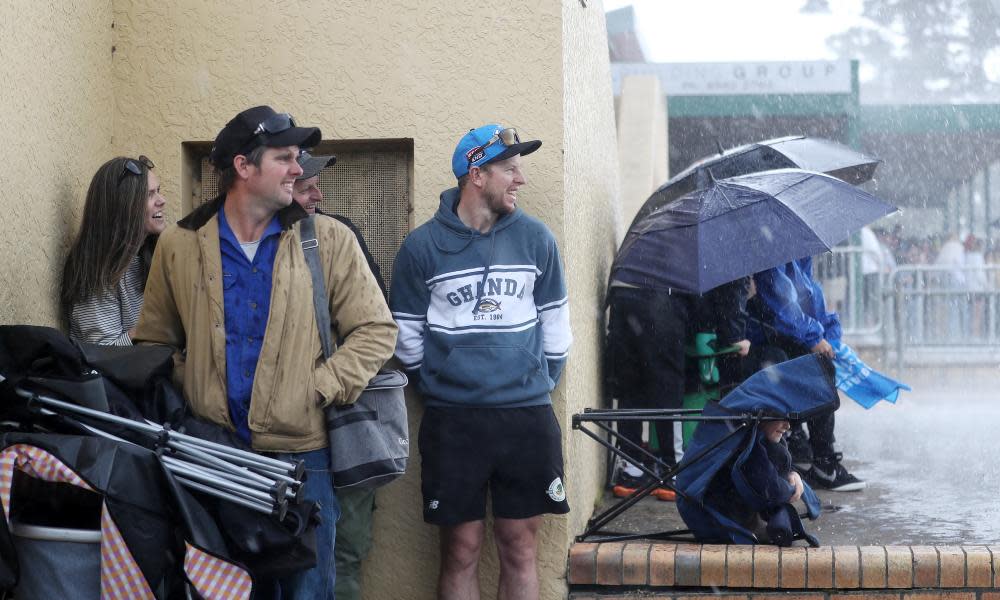Australia has second wettest spring on record, with parts of country coldest in decades

Large parts of Australia shivered through the coldest spring in decades this year, with Sydney and Melbourne failing to record a single 30C day, as drenching rains contributed to the second-wettest spring on record.
Melbourne, Adelaide and Canberra endured the coldest daytime temperatures in 30 years, with maximums at least one degree below the long-term average. Brisbane’s spring was the coldest in 12 years and Perth’s was the coldest in six.
The weather was particularly rare considering the influence of global heating, which is contributing to warmer seasons. It was only the second time in the past 20 years the mean maximum across Australia was below the long-term average for spring.
Australia, we know, was on the cool side in November, given all the cloud cover and ample surface water available. It was the coolest November since 1999, @BOM_au says. pic.twitter.com/2bqPQQE8o9
— @phannam@mastodon.green (@p_hannam) December 1, 2022
Sydney’s maximum temperatures were the lowest in four years, but mean temperatures were the coldest since 2003 and the usually sunny city failed to reach 30C for the first time in three decades.
For some western suburbs of Sydney, including Penrith, it was the first spring on record not to see 30C, as cloudy conditions pushed down maximums.
Related: Australia faces worsening extreme weather events latest BoM and CSIRO climate report finds
Melbourne, which usually has at least four 30C days in spring, and Canberra, which usually has at least three, also failed to reach the milestone.
With more unusually cold weather on the way over the next week, #Melbourne is on track to register its coldest November since 1974.
More details here: https://t.co/PB2KEGarXV
📷: https://t.co/zokI8GHcGJ pic.twitter.com/wRqHfFKiFV— Ben Domensino (@Ben_Domensino) November 25, 2022
Perth experienced some sweltering conditions, but its three days of 30C or above were still well below normal. The capital city averages 10 days of 30C or higher in spring.
Hobart had a colder spring in 2021, while Darwin experiences tropical conditions.
Forecasters blamed the cool weather on the La Niña pattern, which contributed to frequent rain and unseasonably active cold fronts sweeping north from the Southern Ocean.
BoM senior climatologist Simon Grainger said it was Australia’s second wettest spring since records began in 1900.
The most recent below-average spring was in 2010 – also a year with a strong negative Indian Ocean Dipole and a La Niña.
“The overall mean temperature was also the coolest since 2010, 0.1 degrees below average,” Grainger said.
“Daytime temperatures were particularly cool, with all the rain there was increased cloud cover over Australia.”
NSW experienced the lowest daytime mean temperatures since 1972, while in Victoria, temperatures were the lowest since 1992.
As flooding continued to wreak havoc on regional communities, this spring was also the second wettest on record in Australia and the wettest for Victoria, NSW and the Murray Darling basin.
November was relatively wet for Australia, as many parts of the country know.... 1/3 (Source: @BOM_au ) pic.twitter.com/5mfKLxxtUn
— @phannam@mastodon.green (@p_hannam) November 30, 2022
“It’s absolutely incredible,” Bureau of Meteorologist forecaster Dr Andrew Watkins told the ABC, “[but] it’s not much of a surprise to people living in those areas.
“There’s lots of areas impacted by floods at the moment, continuing through much of the past six weeks.”
The south-east highlands were greeted with blankets of snow multiple times in November.
Mount Hotham in Victoria’s alpine country was hit with the chilliest November conditions, dropping to a frosty -7C on 16 November, compared with the long-term average of 3.5C.
It was Victoria’s lowest November temperature on record.
The wettest November was in Western Australia’s Christmas Island, which received 516mm of rainfall, compared with the long-term average of 168mm.
WOW! Another 30cm has fallen over the major resorts during the wintry blast early this week! 🥶
This is Mount Hotham early yesterday after the big dump! #Snowvember pic.twitter.com/LrKQLA092c— MELWeather (@Melbweather2022) November 22, 2022
“The Indian Ocean Dipole is dying off very rapidly and that’s what we normally expect at this time of year … so that’s good. La Niña might hang on a little bit longer, it’s starting to weaken a little bit but we’re not out of the woods yet,” Watkins told the ABC.
“[O]ur weather systems are generally farther south than normal at the moment … that’s bringing more onshore flooding to NSW.”
The Bureau of Meteorology’s long-range forecast is projecting higher-than-average rainfall to persist through to February for Australia’s south-east, including eastern Tasmania, before La Niña fizzles.
Related: Why is so much of Australia flooding right now?
Below-average temperatures are also anticipated for south-east Queensland, central and eastern New South Wales, parts of Victoria and Western Australia’s south coast.
“This wet outlook over northern and eastern Australia is consistent with several climate drivers, including La Niña, a weakened negative Indian Ocean Dipole event, a positive phase of the Southern Annular Mode, and record warm waters around Australia,” it said.
“A Madden-Julian Oscillation pulse is strengthening as it moves into the western Pacific region, which may also contribute to wetter conditions for parts of north-eastern Australia.”
Grainger said while there was still an increased chance of a wet summer for parts of eastern Australia, below-average rainfall was projected for Western Australia and inland areas in parts of South Australia, the Northern Territory and NSW.
“Climate models are pointing to the easing of La Nina conditions in early 2023,” Grainger said, bringing increased risk of bushfires after a long wet period.
“Rainfall promotes a significant amount of growth in grassland areas … if that dries out, there’s a higher fuel load for grass fires.”

 Yahoo Movies
Yahoo Movies 
